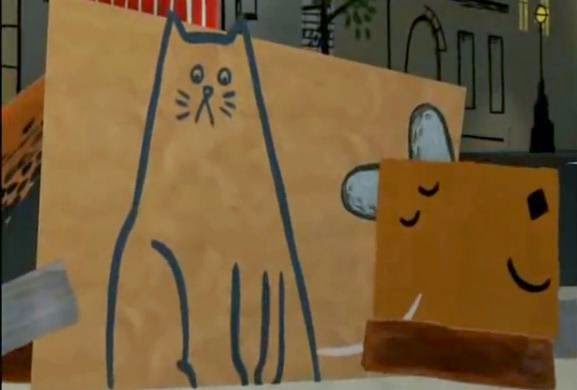Lepore uses the animation method of pixilation to create her short film, she uses natural materials, sand and snow to create the figures in natural light. Depending on natural light meant the the photography of the scenes had to be in the same time of day to run with the previous shots, meaning the weather had to be taken into consideration as well as to ensure that the rain wouldnt ruin the sand and the snow figure as well as the lack of light.
The main narrative for this short film follows a sand figure who empties a bottle of snow which was carried to shore by the sea foam. After emptying the bottle the figure fills it with sand and puts it back into the sea. The bottle arrives to the shore of a snowy terrain and is picked up by a snow figure much like the sand figure. The bottle is then sent back and forth between these two figures with different items in them, ranging from seeds to seaweed, that eventually make facial features for both of the figures. The short film concluded with both of the figures meeting in the sea but only to dissolve before they are able to stand in front of each other.
 |
| Screen shot of 'Bottle' |
The passing back and forth of the bottle reminded me of Ray Johnsons mail art, a neo dadaist who experimented and collaborated with other artists with mail. Johnson wanted to use this concept of talking to each other through mail, through the use of art, how art would be effected, what would happen if someone added to this mail art? Would this make it someone elses possession, someone elses identity. In my opinion the contents of the bottle, change the concept of the bottle, it changes just like the mail art that Ray Johnson created. The contents of the bottle changed the identity of the figures, the objects gave each of figures an appearance that each thought was an identity. This could be further linked to social media in the modern world, through how you present yourself anonymously, an artificial persona that is expected or created by the masses.
 |
| Ray Johnson Mail Art |
Melchior uses computer generated 2-D animation to create his short film. She uses block geometric shapes for the dog character and curved lineart for the cats, with a mainly desaturated colour scheme.
The narrative shows a dog with a cat drawn inside its body, the audience follows the main characters as they wonder the city and how they interact with one another. The cat scratches the dog and the dog retaliates causing them to fall into the water, as they sink deeper the characters learn to work together to co-exist. As they resurface they discover another character just like them, but with the cat presented like the dog and the dog inside the cat. I believe that this animation shows the viewer a contrast of characters that we would stereotypically think that dogs hate cats and vice versa. The identity of this character is lost, the viewer question which is the most dominant role, the cat inside the dog or the dog? This can suggest that people forcibly identity the character as the dog, as the dog is more prominent compared to the cat.
This can be linked to transgender, the struggle of not wanting anyone to know about their true identity or not sure themselves in what their true identity is. The cat could be symbolism through the curves of the lineart as the female role with the angular forms of the dog symbolising the male role.
In addition it could also be seen as a struggle with mental health issues for instance spilt personalities, through how the dog is oblivious to issues and the cat being self aware, able to look after themselves compared to dogs.
Comparing these animations, there is a strong theme of identity in both of the short films however both approach this theme differently. For instance, the 'Bottle' shows the identity perceived by others and how they cloak themselves in this different persona, how people also want to be seen. It appeals and is understood by an older audience compared to a young audience, the underlying message would most likely be lost by the younger audience through the appearance of the short film. Whereas in 'The dog who was a cat inside' suggests the struggle of identity not only to themselves but to the public and can be enjoyed by a younger audience through the cartoon appeal of the animation, the narrative can still be seen as just a dog and cat who finds another like them, with the older audience perceiving the identity theme. It could be seen as offensive to people who do struggle with identity, through how it is portrayed in a cartoon appeal, it could be suggested that the cartoon appeal makes light of the theme. However if the theme was created in film, it could be seen as taking light of mistaken or lost identity as well, it would be hard to create such a deep contextual film that could be shown to both young and older audiences. The animation makes it easier to show to all ages, ensuring that the message is seen by all of the audience.

No comments:
Post a Comment